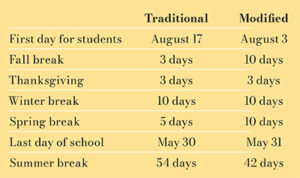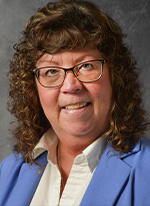Yard signs and billboards can be seen across the city of Peoria, reminding residents that classes in Peoria Public Schools are starting earlier than ever in the district that serves close to 13,000 students.
The 2022-23 school year begins Wednesday, Aug. 3 for students, two weeks earlier than in past years. Teachers report Monday, Aug. 1 for two institute days before pre-K through 12th-grade students return to classrooms following a shorter summer break than at other Peoria-area districts.
The shift to a modified school calendar follows the Board of Education’s 4-3 vote last February in support of the change. There will be longer fall and spring breaks – two weeks – and a shorter summer break, 42 days rather than the 54 days under a traditional calendar. Thanksgiving and winter breaks remain the same.
Peoria Superintendent Sharon Desmoulin-Kherat said the move was discussed for several years as school leaders heard community feedback regarding a longer year and more educational opportunities for children.
What are the benefits?
 District 150 leaders looked at various districts across the state and country, including Rockford, Illinois, and Brown County, Indiana. The calendar also was piloted for a year at District 150’s Harrison School, which has been renamed Annie Jo Gordon Community Learning Center.
District 150 leaders looked at various districts across the state and country, including Rockford, Illinois, and Brown County, Indiana. The calendar also was piloted for a year at District 150’s Harrison School, which has been renamed Annie Jo Gordon Community Learning Center.
“What we learned is that modified is a better fit for us,” Desmoulin-Kherat said. “We were pleased with the result we saw from Harrison’s pilot … Their data reflects a decrease in office referrals and a heightened morale.”
Desmoulin-Kherat said the modified calendar shouldn’t be confused with a year-round school calendar or a balanced calendar, which has schools operating in 45 day stretches with three-week breaks in between.
“The modified calendar allows for the same number of attendance days as a traditional calendar, but the pie is more evenly distributed to allow for rest and respite and additional support for those students who need it,” she said.
The new calendar, Desmoulin-Kherat said, also provides the following:
- Opportunities for high school students to catch up and make up failing grades;
- More one-on-one educational support at the K-8 level;
- Break-away time for families at multiple points in the year;
- An extra two weeks for college visits by high school students;
- A reduction in summer learning loss;
- A chance for students and staff to focus on overall well-being;
- A potential decrease in discipline issues;
- A reset after each break to reinforce positive behaviors.
A vote against the change
Gregory Wilson, who was recently re-elected to the Peoria Public Schools Board of Education, was board president at the time of the calendar vote. He was one of three board members in opposition.
His concerns were that “some of our families were not able to voice their opinions on the modified calendar,” he said. “We have close to 13,000 students, so about 7,000 families, give or take. Their voices weren’t heard. We only saw four or five parents routinely attend meetings to express their views.”
A petition opposing the change was posted online at change.org and received 782 signatures of parents, teachers and students.
“There is simply not enough evidence to suggest that students benefit from schooling with a shorter summer break,” the petition states. “It is neither socially nor academically beneficial because most American schools do not operate on that schedule.”
Among the concerns raised in the petition:
- Families and employees with children who attend other districts with a traditional calendar would be negatively impacted;
- Parents would have the additional burden of arranging child care during the extended fall and spring breaks;
- More economically stable families may leave the district;
- Family summer vacation plans would be disrupted;
- Summer job opportunities for students who need to work to pay for college would be reduced.
What teachers say
An initial survey of union members indicated teachers were split 50-50.
“Given that data, I told the superintendent we would stay out of the fray,” said Jeff Adkins-Dutro, president of the Peoria Federation of Teachers. “Later, however, we surveyed our members again and the vast majority were against switching to a new calendar.”
That second survey of 663 union members showed 447 — two-thirds — in favor of keeping the traditional calendar.
“My concern,” Adkins-Dutro said, “is about teachers working breaks (and) getting burned out. This schedule was touted as a kind of stress reducer for teachers and students. If we have to have a high number of teachers work the breaks, I worry that they won’t get enough of a break throughout the year.”
What’s happening elsewhere?
“We believe that districts understand the needs of their communities best, and as such, calendars are left up to their discretion as long as statutory requirements are met for the minimum term length and minimum number of actual pupil attendance days,” said Liam Chan Hodges, media coordinator for the Illinois State Board of Education (ISBE).
All school calendars, he said, are submitted to the appropriate Regional Office of Education or Intermediate Service Center for approval. Those are then sent to ISBE for approval.
Beginning Aug. 3, Peoria’s schools are starting anywhere from seven days to two full weeks earlier than neighboring districts. Washington elementary schools begin Aug. 10, Morton schools Aug. 11, followed by East Peoria and Washington high schools on Aug. 12. Germantown Hills begins Aug. 15, with Metamora High School starting Aug. 16. Peoria Heights, Dunlap, Limestone and Pekin districts and East Peoria elementary schools begin Aug. 17.
In the U.S., the start of a school calendar varies by region, according to Dianne Renn, associate chairwoman and associate professor at Illinois State University’s Department of Educational Administration and Foundations.
“Schools remain under local control largely because they are funded by local taxes, and no community willingly gives up the purse strings and control over core values represented in education,” said Renn, who has 40 years of experience as a teacher, teacher educator and policy expert. “Many people have input into this highly localized system of funding and governance, so variation is bound to result.
“I am from Wisconsin where, by legislative mandate, no district can start school before Labor Day, not because of farm labor, particularly, but to have a student labor force for the tourist trade,” she said. “So local context matters, even though there has been standardization of school calendars. Geography matters.”
Wisconsin is not likely alone in needing high school and college students “as labor for shops, restaurants, resorts and all the features that go into a lively summer tourist economy,” she said.
The 180-day calendar used by the American school system is a bit of an anomaly, said Renn. Japan, for example, has its students in classrooms 240 days each school year. China, Finland, Germany, Singapore and the U.K. have 199-day calendars.
The politics
The traditional calendar, Renn said, can mean a loss of learning during the summer, and this is the age of accountability, after all.
“Year-round schooling is based on quarterly vacations, so predictability might be seen as a benefit,” she said. “Modified is more flexible, giving local districts more power to arrange their 180 mandated school days as they see fit.”
As soon as you alter the school calendar, you send families scrambling, said Renn.
“Lives are upended because schools serve an often-unacknowledged role in the adult workforce as education’s ‘babysitting’ function. The problems are real for all families,” she said. “For those families holding multiple jobs and relying on public transportation, for example, this can be a nightmare. Good child care is by no means an easy thing to find. It’s just hard for everyone to make the switch despite the documented benefits of newer school calendar models.”
Like so many other topics, education has become highly politicized.
“It may be the case that more affluent people do not really benefit. They can give their kids more during the summer like camps, vacations, trips to the library and books in the home,” she said. “If people don’t see themselves benefiting, they may not support the proposed changes. It works well enough for them now.”
Rising to the occasion
 Now that the change has been made, Wilson said the district needs to be proactive and collaborate with community agencies to create more opportunities for students.
Now that the change has been made, Wilson said the district needs to be proactive and collaborate with community agencies to create more opportunities for students.
“Even though school will be out at random times, the school will not be closed for those students who need extra help,” he said. “That’s one of the big advantages …
And that’s where our relationships with community agencies can also play a role.”
Despite his vote against the change, Wilson believes “our families are going to adjust quite well. The city of Peoria is resilient.”
Desmoulin-Kherat insists that the calendar change will provide much-needed rest for students and staff.
“I think once individuals have gotten into the routine, they’ll find it beneficial,” she said. “The biggest thing for us is the respite for student and staff and this will impact everything – improving the culture of the school with an increase in positive behaviors.”
As a board, Wilson said evaluation of how well things are working “will be a continuing metric we look at.”
Adkins-Dutro said union members will be surveyed again, perhaps after fall break.
“It’s hard to think about everything up front with a change like this, but once we’re back in action, the pros and cons will quickly rise to the surface,” he said. “If an overwhelming number of teachers are not liking the new schedule, we will push for a return to the traditional schedule.”
Historically, the story always went, American public schools used a 10-month calendar due to the needs of farmers.
While that certainly has been an influence, the story is richer and more multi-dimensional, according to Dianne Renn, Ph.D, associate chair and associate professor at Illinois State University’s Department of Educational Administration and Foundations. The agrarian calendar remains alive and well even though most kids no longer labor on the farm.
“Climatization and economics have had outsized impacts on the school calendar. In the first case, before the ability to adequately heat and cool schools, many districts – urban and rural – had both summer and winter breaks that were simply about creating an environment suitable for learning without undue hardship,” she said. “Even after more effective means of heating and any kind of cooling came along, many schools were not equipped for summer instruction. That requires infrastructure investments that may mean building all new facilities.”
As for economics, the expectations gap generated by changing economic conditions and schooling have driven discontent with education and pressure for school reform, she said.
From the pre-Civil War era through the present, educational reform has been all about meeting the workforce needs of society. Things like the American high school and a standardized number of school days became the norm.
“It wasn’t until the late 20th century that standardization and expectations for achievement said to align with the new global economy created pressure for education reform, albeit without an increase in resources,” Renn said. “We are still living in a time when this is shaking out, and schools are framed in a negative light without the recognition that it is the gap with economic expectations that generates so much of the concern.”






